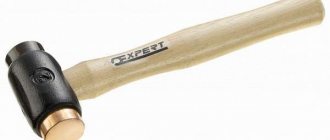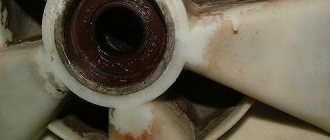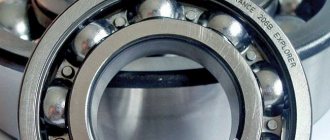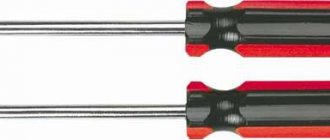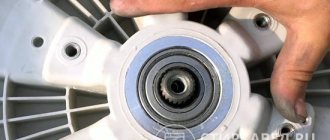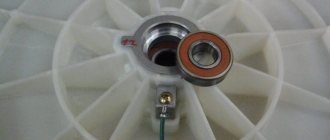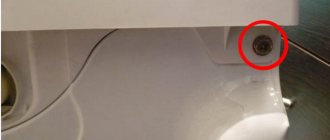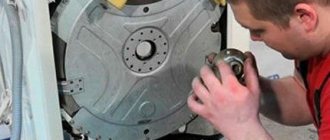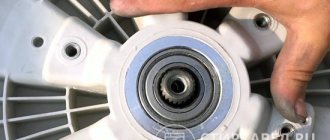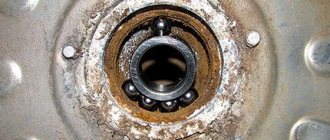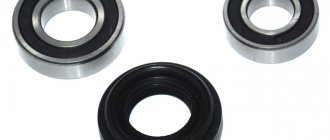The washing machine worked diligently for a long time, but one sad day a strange noise appeared while spinning clothes at high speeds.
Most likely the bearings have worn out and you need to react to this as quickly as possible to avoid wear of the housing. Perhaps nothing bad happened and you only need to lubricate the washing machine drum bearings, which, of course, will significantly extend the life of the equipment. How to do it?
Bearings in a washing machine
This part is the most important element, the performance of which is required for the proper functioning of the equipment. Let's look at the main aspects of the product:
Description
A bearing assembly is a link connecting the pulley and drum of the equipment. It is most often installed in a cross located in the tank. The assembly includes two types of bearings, which differ significantly in size, distributed as an internal part and an external one.
Manufacturers present two types of parts - metal and plastic. The first type is considered more resistant to wear.
Purpose
The part is installed on the drum shaft; when the equipment is operating, the bearings control the correct operation of the device. The rotation is smooth and without any beats or vibrations.
Stages of work
You need to start by disassembling the washing machine and removing the bearings. For any brand and model, the disassembly principle is almost the same.
Start by removing the panels
Remove the top cover by removing the screws from the back that hold it in place. Then push it forward and out of the way.
Remove all the screws around the perimeter of the back panel that hold it in place. Now move to the front of the case.
- Pull out the detergent tray by pressing the lock in the center.
- Unscrew the bolts that are located behind the tray, as well as on the opposite side of the control panel.
- Release the plastic latches and remove the control panel. If you decide to unfasten all connections, take photographs of their locations in advance.
- Open the hatch door. Bend the cuff and remove the clamp. Place the sealing rubber inside the tank.
- Remove the two screws holding the hatch lock. Unfasten the wiring from the lock.
- Unscrew all screws holding the front panel.
Remove parts from top of tank
Remove the upper counterweight by unscrewing the mounting bolts.
Now you need to get the powder receptacle. Using pliers, loosen the clamp that secures the pipe to the cuvette. Disconnect the pipe. The filler valve hoses are also attached to the powder receiver. You can disconnect them, but it is easier to remove them together with the valve. For this:
- Unscrew the bolt on the back wall that holds the valve.
- Disconnect the wiring from the valve and remove it from the housing along with the cuvette.
Also unfasten the pressure switch hose that is attached to the tank.
Move to the front of the body
Remove the front tank counterweights by unscrewing the bolts.
If the heating element of your washing machine is located in front under the tank, disconnect its connectors. Then, using wire cutters, remove the wiring clamps and remove it from the tank. Unscrew the screw of the drain pipe clamp. Remove it from the tank.
Be careful, water may spill out of the spigot.
Disassemble from behind
Remove the drive belt by pulling it to the side and turning the pulley.
If the heating element of the car is located at the rear, unfasten its wiring, as well as the engine connectors. Now unscrew the motor bolts and pull it out of the housing.
Unclench the plastic clip and unfasten the pressure chamber that is attached to the tank. Unscrew the shock absorber bolts. Lift the tank and remove it from the hooks, pulling it out of the housing.
Place the tank on a flat surface. Remove the sealing rubber of the hatch by removing the inner clamp. Turn the tank over and remove the pulley by unscrewing the central bolt. Pre-secure it with a wooden plank.
Separate the two parts of the tank by unscrewing the screws around the perimeter. Take out the drum. Now you get to the bearings. Now you will learn how to properly lubricate a bearing in a washing machine.
Finish work
Remove the bearings from the tank. To do this, pry the oil seal with a screwdriver and pull it out. Place a chisel on the outer race of the bearing and, tapping with a hammer, knock it out of the tank. Do the same with the second element.
If you have decided which bearing lubricant is best to choose, then after cleaning you need to remove the protective cover of the part. The product is placed inside.
But how is a non-separable, sealed bearing lubricated?
- Take WD-40, spray the parts with it and wipe well with a rag.
- After cleaning, you need to open the lid, but it does not work.
- Fill the inner ring of the part with a plastic bag.
- Take a tube of lubricant and cut the neck so that it is equal to the diameter of the inner ring of the bearing.
- Place the tube on the inner race and squeeze out the lubricant until it starts to come out from the opposite side.
- Then start rolling the bag around inside to distribute the lubricant. If you were wondering whether sealed bearings need to be lubricated, now you know what is necessary and possible.
- Remove any excess. Reinstall the part.
How to lubricate the bearing in a washing machine?
Timely care of the part will significantly extend the service life of the equipment. But the lubricant, in turn, must be selected carefully and in accordance with the requirements of household equipment.
There are a sufficient number of varieties of this composition on the modern market. The right choice will provide reliable protection of the part from wear, the main thing is to select the lubricant characteristics according to the requirements of the washing machine.
It must meet the following parameters:
- Availability of moisture resistance.
The oil seal is a sealing ring that is attached to the bearing itself, which rotates on the shaft. Thanks to this, water does not penetrate into the part. Therefore, the lubricant should not be washed away during operation of the mechanism.
- Heat resistance.
The water in the drum sometimes heats up to 90 degrees, which should be taken into account when purchasing a lubricant; it should not lose its characteristics when heated.
- Suitable.
An important aspect is compatibility with rubber; a poor-quality composition can ruin it - greatly soften it or, on the contrary, make it hard and unsuitable for use.
- Density.
The grease must remain on the bearing even when the drum is heavily loaded.
Important to remember! You cannot use the automotive version of the lubricant, as they are not intended for washing machines. Bearings quickly fail after using such a lubricant.
Areas of use
Aerosol and liquid lubricants are used mainly to create a separating layer, to protect and restore rubber seals, and also to lubricate lightly loaded plastic parts.
Greases are less often used as release agents, but they are used in more heavily loaded mechanisms, bearings, hinges, guides, and gears.
The use of silicone grease will help increase the level of electrical insulation or get rid of squeaking in plastic parts or in the brake system.
Industrial Applications
In industry, these materials are also widely used for lubrication of molds, dies, dies, lubrication of knives and sealing jaws in packaging equipment, lubrication of conveyor belts, bearings and guides, lubrication of pneumatic equipment, lubrication of working tools for storage, etc.
One way to protect surfaces from welding sparks and splashes is also to treat them with silicone fluids.
Auto applications
To better understand what silicone lubricant is needed for, let's look at some examples of its most popular automotive applications:
- Restoring the color of plastic parts
- Preventing rubber parts from aging
- For lubrication of disc brake system parts
- Lubricating plastic parts of the car body interior to get rid of squeaks
- Restoring the elasticity of rubber parts and seals
- For lubricating wheel tires during their upcoming long-term storage
- For lubrication of car locks, hinges, hinges
- For lubrication of seat guides, sunroofs, window regulators
- To protect door and hood seals from freezing in winter
- For lubrication of control cables in sheaths
- For lubricating rubber bushings, pipes, engine mounts, etc.
- To improve the electrical insulating properties of high-voltage wires
Silicone grease can ensure absolute sealing of spark plugs before extreme trips.
But silicone lubricant has many uses not only in the automotive field.
Household applications
In domestic conditions, it can be used to lubricate door hinges and locks, window and furniture fittings, treat window rubber seals, and be used for the repair and maintenance of small household appliances (electric shavers, hair clippers, mixers, sewing machines, coffee machines, fishing reels, computer fans), sports simulators.
What happens if you don't lubricate bearings in washing machines?
Some people wonder whether it is necessary to lubricate this element? Preferably, experts say so. Bearings are responsible for the performance of the equipment; if noise and grinding noises appear in the product, it means that the drum is not working properly.
The bearings are responsible for the serviceability of this part; they ensure smooth rotation of the drum.
If a grinding noise appears, it means that it is not spinning smoothly, and therefore may soon become unusable. In addition, this may cause the operation of other parts that are part of the washing machine to malfunction. The result of this problem may be the final breakdown of the equipment, which will no longer be subject to restoration.
Disassembling the tank
How to get to the washing machine bearing depending on the type of tank? It is known that tanks can be either solid or collapsible. The first option is found in the Indesit and Ariston models. LG and AEG cars are equipped with collapsible tanks.
If the tank is collapsible, the bearing can be removed after first unscrewing the bolts. If the tank cannot be disassembled, you will need to carefully go along the seam with an angle grinder (grinder). If you do not follow this recommendation, you may encounter a serious problem during tank assembly.
To remove the bearings you must:
- unscrew the nut securing the drum pulley;
- remove the drum;
- You can remove the bearings on both sides using a puller designed for such procedures.
To lubricate the bearing in an Ariston washing machine, you will need to clean the part from dirt, wipe it dry, and then remove the protective cover and lubricate it with the chosen product.
How to find a bearing in a washing machine?
To find this part you need to complete several steps:
- Disassembling the washing machine;
To do this, you need to remove the cover by unscrewing two bolts located on the rear panel. Then the tray for the washing powder is removed, then the upper instrument part is removed by unscrewing all the bolts on it. Next, the wires are disconnected.
Important! The process of disassembling the product must be photographed in detail so as not to confuse the assembly sequence later.
Removing the bottom strip is simple and quick using a flat-head screwdriver.
- Removing the hatch cuff;
This is the name of the rubber gasket, which is the connecting element between the drum and the hatch opening.
- Removing the front panel;
You can’t pull it too hard, as you can damage the integrity of the part.
- Removing and disassembling the tank.
This stage requires care and the right approach. It is imperative to photograph the process in great detail, since disassembling the tank is difficult.
General qualities of various oil seals
The type of seal used by the manufacturer may vary. However, it will always be based on a special metal insert. It is necessary to ensure that the part retains its correct shape for a long time. It performs a reinforcing function.
IMPORTANT! Please note that during operation of the washing machine, the axle shaft on which the tank and drum are mounted constantly rotates. Since this element of the washer is in direct contact with the oil seal, it wears out very quickly. After all, the friction force is great.
It is clear that this process can be slowed down today. Lubrication reduces the coefficient of friction. After all, it provides sliding. At the same time, any lubricant moisturizes the oil seal. And that’s why it doesn’t dry out.
Tips for using your washing machine
Proper use of household appliances is an important aspect in operation. To avoid sudden breakdowns, it is advisable to follow some recommendations:
- Do not load the body of the washing machine;
- There is no pressure on the loading hatch;
- It is not advisable to allow small children who actively use the software buttons unnecessarily to access the device;
- Pets must be kept in close proximity to the device;
- Avoid transfusion;
- Use the device strictly according to the instructions;
- It is not advisable to change the program mode when water has already been collected in the machine;
- Do not rinse the drum with a stream of running water;
- To care for the product, use mild cleaning agents that do not scratch the surface.
What kind of lubricant
First of all, you need to decide on the material. Experts recommend not combining different types, but using one lubricant for all parts. Don't rush into the store - read the specifications carefully.
Properties of lubricant for washing machines:
- moisture resistance,
- high viscosity,
- heat resistance (some machines have a boiling mode, which means the lubricant should keep 90-100 degrees Celsius),
- neutrality.
The last factor is of great importance, especially when it comes to bearings. It is closed by a rubber gasket - an oil seal. Aggressive lubricant will turn it into an inelastic disc or into a loose substance. Such a seal will not protect the bearing, water will get inside, oxidation will begin, and, most likely, the part will break and will have to be replaced with a new one.
WD-40 is usually used to remove rust, salt deposits (lime) and dirt. This is the most popular household product today, and it does its job quite well. An additional plus is the thin proboscis on the sprayer, which delivers the cleaner more accurately.
TOP 5 lubricants for washing machines:
- Amplifon.
- Anderol.
- Staburags NBU 12.
- Liqui Moly "Silicon-Fett".
- Huskey Lube-O-Seal PTFE Grease.
These brands are used in workshops and service centers and are convenient for use independently. Liqui is the most expensive, which pays off with high quality and ideal compatibility with all types of oil seals. Anderol is directly indicated in the instructions for Indesit machines as recommended.
Which lubricants are better?
Litol-24. Production: mineral oils are thickened with a mixture of lithium technical soaps with the addition of antioxidant additives. Pros: waterproof, high chemical and thermal resistance. If you remove the temperature range, it will be from -45 to +139 °C. Adequate replacement for SHELL.
CIATIM-221. The advantages include resistance to high temperatures and stability during prolonged friction, which has a positive effect on the operation of the bearing seal; waterproof. The downside is weak hygroscopicity, i.e. With constant exposure to a humid environment, the material becomes unusable, although this process can take years. A good replacement is the SHELL series.
LITIN 2. In this case, we are dealing with a highly specialized product intended for use in extreme conditions on vehicle components, which means it has a multiple margin of safety and “survivability.” This product has proven itself to be a worthy replacement for products from a brand such as SHELL, which in itself is a high indicator.
CIATIM-201. This product has found its application in friction points of aircraft equipment, where it is necessary to relieve high thermal stress. The lubricant remains operational for more than 600 hours of flight time.
CV joint-4M. Used in extreme motorsports to lubricate ball suspensions and joints of racing cars. It has unique antioxidant and extreme pressure additives and is extremely waterproof.
It should be understood that any material can be removed and replaced with an analogue. Thus, when choosing a lubricant in a store, you should first of all focus on the price according to the principle “good things cannot be cheap,” and the use of the product is designed for at least years to come.
Part replacement
The location of the bearings requiring replacement is the rear wall of the removed drum. Before you get them out, you need to remove the oil seal. To do this, a straight-pin screwdriver is used, which simultaneously prys up and removes the oil seal, which is thoroughly inspected and, if necessary, replaced.
The next step is to remove the internal (small) and external (large) bearing. The process is carried out using a punch (metal rod) and a hammer. The outer bearing is knocked out first, the inner bearing second.
Next, you should make sure that the new parts are installed in a clean seat. The small bearing is installed first, and the large bearing second. Parts are also hammered using a metal rod installed according to the “crosswise” principle. The dull sound emitted by the part during the driving process becomes louder at the stage of correct installation.
Before installation, the oil seal must be treated with a lubricant with water-repellent characteristics. The installed part is a signal for assembling the washing machine in the reverse order to how it was disassembled.
Craftsmen claim that changing bearings in a Candy washing machine is not a very complicated process. The main condition is consistency, caution and attention to detail, especially fragile ones. Advice for those who doubt their own strengths and abilities: seek the help of professionals. But remember that getting a bearing replaced by a professional will cost money - approximately 30% of the price paid for a new Candy machine.
